[unable to retrieve full-text content]
New research gives more reasons to eat less-processed food The GuardianNew research gives more reasons to eat less-processed food - The Guardian
Read More
[unable to retrieve full-text content]
New research gives more reasons to eat less-processed food The GuardianWhy Kids Don't Eat Enough Seafood and How They Can Enjoy It
this link is to an external site that may or may not meet accessibility guidelines.
Nothing ruins the excitement of a good, homemade meal like the impending doom of feeling queasy afterward. The occasional case of heartburn is one thing, but if you always feel sick after eating, there’s a good chance an underlying health issue is to blame. Below, a doctor weighs in on what your nausea after eating might mean, associated symptoms, and when to see a doctor about it.
“Nausea is a symptom that can occur due to many underlying root causes, but if it specifically occurs after eating, it likely is due to abnormalities in the gastrointestinal system,” explains Hugh Humphery, M.D., functional medicine practitioner and Everlywell advisor. Other potential causes, he adds, are mental health-related. Some of these common disruptive conditions are:
Acid reflux happens when stomach acids bubble up into your esophagus and throat, often after eating. The occasional bout—especially after eating spicy foods—is expected, but if you’re experiencing it regularly, you could have what’s known as gastroesophageal reflux disease (GERD), which can also come with nausea and bloating. Food sensitivities and a “leaky gut” or intestinal permeability are additional possible complicating factors, adds Dr. Humphery.
“Anxiety, depression, or intense stress can also result in a loss of appetite and nausea after eating,” says Dr. Humphery. Everyone has different physical reactions to the body entering “fight or flight” mode, and research shows that the stress and anxiety have direct effect on colonic movements and how hormone interact with the GI tract. Other symptoms that may coincide with this type of upset stomach are fatigue, muscle aches, and restlessness, Dr. Humphery says.
Dr. Humphery says gastritis is characterized by inflammation of the stomach lining, which, according to the Mayo Clinic, may also come with abdominal pain, nausea, and a sensation of fullness in the upper abdomen after eating. “If vomiting occurs for more than 24 hours or there are signs of dehydration or serious illness such as high fever, one should consult their doctor immediately,” Dr. Humphery adds.
An ulcer is an open sore that develops on the stomach’s inner lining, and can cause nausea, heartburn, stomach pain, bloating, and an intolerance of fatty foods, per the Mayo Clinic. Dr. Humphery says it, therefore, can be linked to nausea after eating.
If you’ve ever had a stomach bug and struggled to keep any food down, you’ve experienced this specific type of post-meal nausea. This is commonly known as the stomach flu and also often comes with diarrhea, cramping, and fever, per the National Institute of Diabetes and Digestive and Kidney Diseases.
Hormonal changes, particularly during pregnancy, can cause nausea after eating, says Dr. Humphery.
This may seem like an obvious one, but food allergies can cause adverse reactions, including nausea, Dr. Humphery explains. They may also come with skin discomfort and itching, he adds.
“The cause of your nausea will determine how you treat and prevent it,” says Dr. Humphery. “Consider keeping a food diary if you commonly experience nausea after eating and aren’t sure of the cause.” He also recommends getting fresh air, deep breathing meditation, taking an over-the-counter antacid like TUMS, and avoiding intense physical activity after a meal.
To prevent feeling uneasy in the first place, he suggests eating and drinking more slowly, avoiding spicy, fried, and greasy foods, and eating small meals spread out throughout the day rather than two or three larger ones.
“If your nausea does not go away within a week, call your doctor to discuss your symptoms,” says Dr. Humphery. “If your nausea is accompanied by blood in your vomit or stool, high fever, chest pain, extreme thirst and jaundice, or yellowing in the eyes or skin, you should contact your doctor immediately.”
Kayla Blanton is a freelance writer who reports on all things health and nutrition for Men’s Health, Women’s Health, and Prevention. Her hobbies include perpetual coffee sipping and pretending to be a Chopped contestant while cooking.


Photos by Zachary BonDurant
Prescott Field at Grand Canyon University was lined with students eagerly waiting to enter and swipe, tap or scan their credit cards. Rows of student merchandise were before them, including homemade jewelry, thrifted clothing, upcycled clothing, coffee, stickers and baked goods.
Canyon Activities Board’s First Monday, a market where students can set up and sell merchandise for other students, was a success in its first year as part of Welcome Week.
“A lot of the things we do are, of course, for students, but it is fun that our students are doing things for other students — they are the main focus and emphasis,” said CAB Student Activities Manager Meghan Mellinger. “I’m hoping this is a fun new Welcome Week tradition.”
A selection of skee-ball, cornhole and a dance video game created even more of a buzz alongside the free food and refreshments available for those attending the event.
For Josh Toney, First Monday was an opportunity to spread the message of God.
Toney’s apparel brand, Joshua 1, is adorned with graphic designs and Scripture.

“It’s really focused on being bold and being proud of it. It is a reminder for me and everyone who sees my clothing that I’m living for God,” he said.
A graphic design combined with Matthew 17:20 -- “Mustard seed-sized faith can move mountains” --- is one of many examples he uses to show the power of Scripture.
The bold statement does not go unnoticed by others -- the brand is meant to raise questions to people who may not know God.
“So many people come up and ask about it, and we end up having conversations,” said Toney. “That is really what the Gospel is all about.”

Similarly, Ryan Anger sought out a vender spot at First Monday to raise money for a mission trip, the Alaska Mission for Christ, which centers around 1 John 4:19: “We love because He first loved us.”
His bright orange tablecloth was covered with a variety of homemade cookies, including chocolate chip, peanut butter and oatmeal raisin. The process flipped his residence hall room into a bakery.
“Baking started Friday and ended Sunday night,” Anger said. “My dorm-mates don’t like how warm the room gets with the oven on, but you have to do what you have to do.”
It’s worth the trouble.
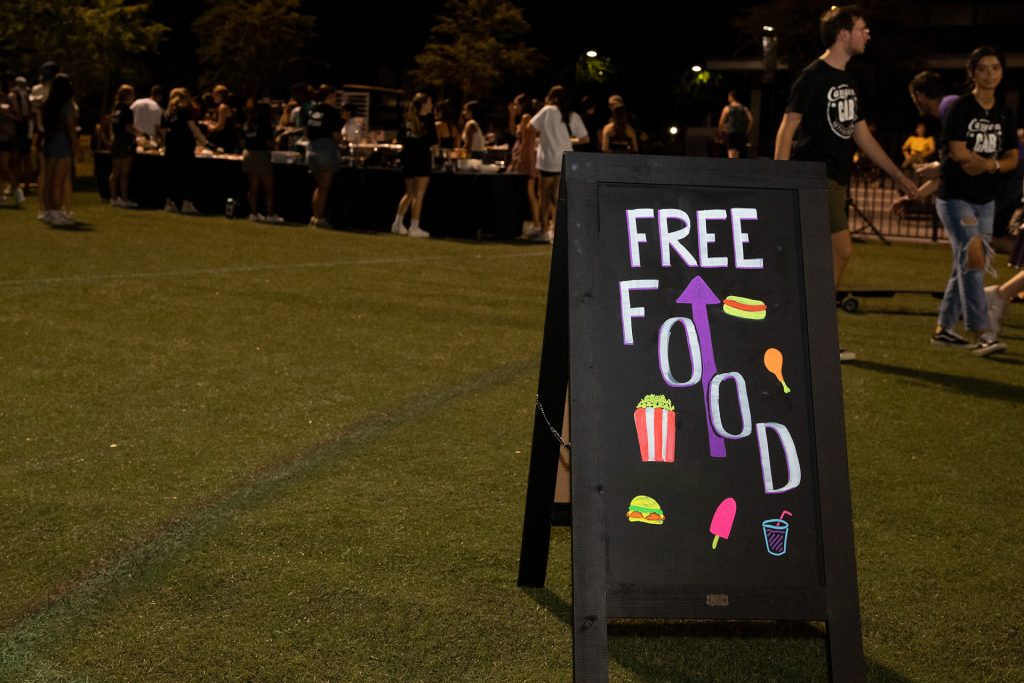
During the mission trip last summer, he traveled to Alaska with a group of contractors and renovated a youth camp. This year, he is hoping to contribute to the renovation of villages.
Toney and Anger were among dozens to lure the big crowd.
Mellinger was pleasantly surprised with the outcome, which set the tone for the rest of the week.
“CAB is putting on other events throughout Welcome Week and this is only the first night,” she said. “So, we thought it would be a little smaller as opposed to our other events throughout Welcome Week – but it looks like we have most of the campus here.”
Contact staff writer Lydia P. Robles at 602-639-7665 or [email protected]
****
Related content:
GCU News: Welcome Crew puts the 'Woohoo!' in arrival
GCU News: Start spreading the news: It's Welcome Week!
GCU News: Students open the door to fun dorm decor
GCU News: Comfort level of campus keeps expanding
GCU News: Speedfriending had their interest at hello
GCU News: Preparation pays off with many happy returns
Having a dog means asking a lot of questions your dog will never be able to answer. Why do they lick glass? Why do they tilt their heads? And why do they seem to love eating dirt?
Speaking with the American Kennel Club, veterinarian Dr. Laurie S. Coger, DVM, said that munching on soil can be indicative of a dog’s emotional state. A pet that’s stressed or bored may indulge in pica, or the ingestion of non-edible materials. If it’s dirt, then they’re indulging in geophagia.
A dog may also turn to a dirt buffet to try and alleviate some kind of health ailment, like anemia (a low blood cell count), an upset stomach, or some kind of nutritional deficiency. (Gastrointestinal problems are more likely to lead to eating grass, however.)
Despite their reputation for having cast-iron stomachs, you really, really don’t want your dog snacking on dirt. If they eat too much, they can develop an impaction in their intestines that could require surgery to resolve. Dirt is also home to pesticides, toxins, rocks, and other things that could seriously injure an animal.
“I would add that any new, unnatural behavior, such as dirt eating, should be acted upon quickly,” Dr. Coger said. “Both because of possible serious underlying causes and before it becomes a habit. Dogs will learn from other dogs in the house, and who wants a houseful of dirt eaters?”
If you catch your dog scarfing down a dirt meal, take them to a vet to check for any irregularities. If the problem persists, try to keep them busy and active so they’re less inclined to devour the backyard. Some dogs may have a preferred dining spot, which you can close off. If you catch them in the act, you can discourage the behavior by telling them “no” or “please stop eating dirt.” With any luck, they’ll go back to licking glass instead.
[h/t American Kennel Club]
Have you got a Big Question you'd like us to answer? If so, let us know by emailing us at bigquestions@mentalfloss.com.
[unable to retrieve full-text content]
‘Are you kidding me?’ Goats take over deputy’s car, eat his paperwork WHNT News 19[unable to retrieve full-text content]
What are 'Blue Zones' and why should you eat like the people who live in them? Finger Lakes Times
You might be an avid sauerkraut fan if you slather it on your hot dog or pile it onto your Reuben sandwich. On the other hand, sauerkraut might be a food that you’ve never tried — or have any intention of trying. You might change your mind, however, once you learn how this “sour cabbage” can help improve your health.
The word “sauerkraut” might lead you to believe that this food originated in Germany. It’s true that sauerkraut has been a staple in the German diet since the 1600s. But according to the website germanfoods.org, sauerkraut is a Chinese invention, dating back to more than 2,000 years ago, when the Chinese fermented cabbage in rice wine. It’s thought that this fermented cabbage fed the builders of the Great Wall of China during the winter months. A thousand years later, Ghenghis Khan brought this fermented cabbage to Europe. The Europeans then began to ferment cabbage using salt instead of rice wine. Salting the cabbage extracted water and allowed this mixture to ferment, “turning the sugars in the cabbage into lactic acid which served as a preservative,” says the website thespruceeats.com.
While we tend to think of sauerkraut as being German food, this cabbage delicacy is enjoyed by many countries in Europe, including Poland, France, Bulgaria, Croatia, and Russia. Sauerkraut made its way across the pond to North America when the English and German settlers arrived, and it’s long been associated with German communities, such as the Amish, in the U.S.
To get cutting-edge diabetes news, strategies for blood glucose management, nutrition tips, healthy recipes, and more delivered straight to your inbox, sign up for our free newsletters!
You might find it hard to believe that sauerkraut has much to offer in the way of nutrition and health. Surprisingly, it does! Here’s the lowdown:
Sauerkraut is a wealth of good bacteria called probiotics. Probiotics keep your digestive tract happy and healthy, but their benefits extend beyond that: They are thought to reduce inflammation, prevent and treat vaginal and urinary tract infections (UTIs), lower cholesterol levels, and maybe even lessen anxiety and depression.
Thanks to its probiotic, vitamin C, and iron content, sauerkraut helps your immune system fight off colds, flu, and other illnesses and infections.
While eating sauerkraut won’t magically burn off unwanted pounds, it can be a part of a weight-loss plan. That’s because this cabbage dish is low in calories and high in fiber — a winning combination to keep you feeling full, longer. There’s also some research to indicate that sauerkraut’s probiotics could help lessen weight gain and promote weight loss (although more research is needed in this arena).
Sure, you might feel happy munching on a hot dog with sauerkraut, but sauerkraut itself may help ease symptoms of anxiety and depression, thanks to — again — probiotics, but also promoting the uptake of magnesium and zinc in the gut.
Cabbage contains a compound called sulforaphane, which is also found in broccoli and kale. Sulforaphane may prevent the growth of cancer cells. And studies show that a higher intake of cruciferous veggies, including cabbage, is linked with a reduced risk of cancer.
In addition to the above benefits, sauerkraut, along with other fermented foods, may play a role in helping to manage blood sugars by improving insulin secretion from the pancreas and decreasing insulin resistance. While more research is needed, that fact that sauerkraut is low in calories and high in fiber makes it a good choice if you have diabetes.
One cup of canned sauerkraut contains:
One of the drawbacks of commercially prepared sauerkraut is its high sodium content. Fortunately, you can purchase lower-sodium varieties that may have closer to 400 milligrams of sodium.
Some proponents of sauerkraut recommend eating raw sauerkraut rather than canned. With canned sauerkraut, the cabbage is sterilized with heat and then put into glass jars. The heating process may cause the sauerkraut to lose some of its health benefits (including loss of probiotics); plus, it may look yellow in color and taste different. Raw or fresh sauerkraut will be crunchy, have a tangier taste, and have a fresh color.
You can even try your hand at making your own sauerkraut, but if you do, be sure to use sterile equipment and follow the recipe and directions very carefully.
Want to learn more about eating well? Read “Strategies for Healthy Eating,” “Improving Your Recipes: One Step at a Time,” and “Easy Ways to Eat Better.”

Historical sites like Atlas Obscura say mooncakes are to Asians what Christmas fruitcakes are to Western cultures. And similar to Western attitudes to fruitcake, food blogger Suzanne Nuyen told Today, "I feel like mooncakes are a very polarizing food. You either love them or you hate them." No surprises, then, that The Standard says that the people of Hong Kong chose to throw out 2.88 million mooncakes in 2020 simply because they didn't like them. It doesn't help that thanks to its high fat and sugar content, a traditional mooncake can have a minimum of 716 calories, per The Straits Times.
Even though they can be made at home, with sites like Catherine Zhang providing recipes and tips, most mooncakes are purchased from bakeries that specialize in making them, simply because they can be time-consuming to make from scratch. One baker even told Today it could take up to eight hours to make a single batch.
Travel China Guide says mooncakes first made an appearance about 3,000 years ago, and for a time, they were meant to be used as an offering to mark the Mid-Autumn Festival. The actual practice of eating mooncakes didn't come about until the Tang Dynasty, which ruled China between 618 to 907 AD, and it didn't become common practice until late Yuan Dynasty, which lasted from 1271 to 1368 AD.
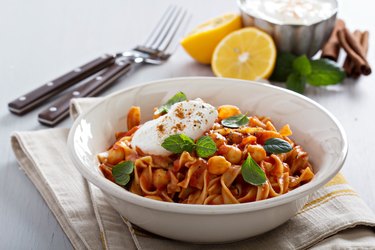
Chickpea pasta contains slow-digesting complex carbs and plant protein to help you feel fuller for longer.
Image Credit: VeselovaElena/iStock/GettyImages
You've probably heard a whole heap of warnings about processed foods and how they're harmful to your health and why you should ditch them from your diet.
Video of the Day
But if you follow this blanket advice and pass over all processed foods, you'd be doing your health a disservice. While some ultra-processed fare like chips and cured meats are innutritious, other less processed food varieties can be an amazing addition to your daily diet.
Take chickpea pasta. While it's processed (chickpeas are dried, ground into flour, then formed into noodles), it's one of the most nutrient-dense foods on the planet. This means that noshing on these non-traditional noodles boasts a boatload of benefits for your body.
Here, experts share the health benefits of chickpea pasta, plus tasty tips to incorporate it into your weekly eating plan.
"The word 'processed' gets a bad rap," says Leslie Langevin, RD, author of The Anti-Inflammatory Kitchen Cookbook and co-owner of Whole Health Nutrition.
But processed simply means that a food is changed, prepared or packaged in a particular way prior to landing on your plate, according to the American Heart Association (AHA).
This processing can range from minimally processed (like frozen fruits or pre-cut veggies) to highly or ultra-processed (like sugary energy drinks and cakes).
We usually hear about the latter's limitations on our health. Indeed, ultra-processed foods contain added sodium, sugars, oils, colors and preservatives. In fact, commercially processed (and restaurant foods) account for most of the sodium (70 percent) in the average American diet, per the AHA.
But this is just one side of the processed spectrum, and changing a food isn't always a negative thing.
For example, some processing involves adding nutrients such as fiber, calcium or vitamin D, or packaging foods to help stop spoilage and enhance food safety (think: canning produce, pasteurizing milk products or vacuum-packing meats), according to the AHA.
Certain types of processing can also increase the digestibility or absorption of nutrients in foods, Langevin says. Examples of this include grinding oats into flour, sprouting grains or soaking beans before cooking them, she says.
And sometimes processing a food — like chickpeas — can create new ways to eat and enjoy it without sacrificing its nutrient profile. "Eating chickpeas in the shape of a pasta noodle both delivers the same nutrition as a chickpea in its whole form and in a fun way to eat for the whole family," Langevin says.
Source: USDA
The health perks of chickpea pasta are plentiful. Here are just a few:
While it depends on the particular brand, the typical chickpea pasta provides more gut-friendly fiber than white or wheat pasta (around 8 grams per serving, compared to 2 and 5 grams, respectively), says Susie Polgreen, RD, CD, a dietitian with Whole Health Nutrition.
Here's why that's a good thing for your gut: Soluble and insoluble fiber help to bulk up your stool and move it along the digestive tract (read: regular, healthy bowel movements), Polgreen says.
Plus, fiber is also a stellar source of prebiotics, which help to feed probiotics (or "good" gut bacteria), Polgreen says. In other words, fiber-rich chickpea pasta is marvelous for your microbiome too.
And with up to 8 grams per serving, just one portion of this legume pasta can help you reach your daily target for fiber of 25 to 38 grams, Langevin says.
If you're longing for linguine, but you need to watch your blood sugar, chickpea pasta is the perfect low-glycemic alternative.
"Because of its high protein and fiber content, chickpea pasta promotes a slower release of glucose into the bloodstream, making it a better choice for blood sugar management than white or wheat pasta," Polgreen says.
Put another way, the fiber in complex carbs like chickpea pasta slows down digestion, whereas your body breaks down and quickly absorbs low-fiber simple carbs — like white pasta — which can send your blood sugar surging and dipping after you dine.
Your high-fiber plate of chickpea pasta may also help protect your heart.
"Eating adequate fiber has been shown to be very important for overall health and disease prevention," Langevin says. Specifically, a high-fiber diet may reduce your risk of certain cancers and heart disease, she says.
Case in point: A February 2019 series of systematic reviews and meta-analyses in The Lancet observed that people on a fiber-rich eating plan (25 to 29 grams of fiber per day) had a 15 to 30 decreased risk of early death due to any cause (including heart issues) and a lower risk of coronary heart disease, stroke, type 2 diabetes and colorectal cancer (versus those who ate less fiber).
Similarly, substituting some plant-based protein (like chickpea pasta) for animal protein (especially red meat) may help support your long-term health. Munching on more meatless meals is linked to a decreased risk of certain cancers and heart-related diseases, according to an August 2019 study in the Journal of the American Medical Association Internal Medicine.
When you consider foods for muscle building, you probably think of meat. But chickpea pasta is a plant-based protein powerhouse, and that's great news for your muscles.
Depending on the brand, chickpea pasta can provide nearly double the protein of regular white pasta and even more than gluten-free rice pastas, which only have around 3 grams of protein per serving, Langevin says.
To build and maintain healthy muscle, Langevin recommends eating 20 to 30 grams of protein at each meal. And with up to 14 grams of protein per portion, chickpea pasta can help you meet this protein range, especially if you follow a plant-based or vegan eating pattern. Yep, a hefty bowl of high-quality protein chickpea noodles can serve as a staple meatless dinner.
But keep in mind: "Like most other beans, chickpeas are incomplete proteins on their own," Langevin says. That means they're missing two essential amino acids (methionine and cysteine) as compared to meat (which contains all nine essential amino acids), she explains.
But this shouldn't deter you from dining on legume pasta. You can still eat your chickpea noodles and get your essential amino acids too. "To make a complete protein out of chickpea pasta, simply serve some toasted walnuts or seeds with the dish or a few whole grains in the same meal," Langevin says.
If your goal is to shed a few pounds (or maintain your current weight), chickpea pasta can help you do just that.
Once again, fiber is the fundamental factor here. That's because fiber helps you feel fuller during and after your meal, Langevin says. Fiber keeps your stomach satisfied and curbs cravings, which are all important for weight loss or weight maintenance.
Protein is another contributing component to this equation as well. Protein takes longer to digest than carbs, so it can also help you feel satiated longer and slash the belly rumbles that make your reach for calorie-rich foods.
For people with food allergies or sensitivities, chickpea pasta can be a satisfying and safe substitute for traditional pasta.
"Legume-based pastas can be a great alternative for those with gluten and/or wheat sensitivities," Polgreen says.
That's because chickpea pasta is naturally gluten-free, Langevin says. It's an even better option than gluten-free rice pastas, which are low in fiber and high in carbs, she adds.
Just be sure to double-check the ingredients list on the back of the box. While some chickpea pasta brands use just chickpea flour, others may use a combination of different flours that may not be gluten-free, Polgreen says.
"Chickpea pasta is easy to incorporate in any dish that you might normally use pasta," Langevin says. Here are some simple ways to start cooking with the bean-based pasta:
Marc Andreesen famously claimed in 2011 that “software is eating the world” in an op-ed article in the Wall Street Journal.
His point was that software was the new engine of value creation.
“My own theory is that we are in the middle of a dramatic and broad technological and economic shift, in which software companies are poised to take over large swathes of the economy,” Andreesen wrote.
The article details a variety of examples in which digital companies, such as Netflix, Amazon, Apple and Spotify, have achieved a dominant position powered by software and digital products. The article defines software rather loosely, asserting that companies use software to trade in digital assets and dramatically expand the use of data and automation are the new winners.
MetaBeat 2022
MetaBeat will bring together thought leaders to give guidance on how metaverse technology will transform the way all industries communicate and do business on October 4 in San Francisco, CA.
Andreesen was right. Software-powered companies have and are eating the world. Though, his analysis focuses on large companies winning considerable victories with industrial-scale software. The software he points to that ate the world was a product of elite engineering teams and layers upon layers of complex platforms.
In my view, we are entering a new era in which software will continue to eat the world, but in a far broader and more distributed way. It won’t just be the most famous or largest companies that achieve digital victories. We will find that in almost every business, the use of software will boom to increase efficiency, bring new awareness and expand automation.
This will never happen if this software can only be created by elite engineering teams.
The way that software will eat the rest of the world will be through low-code and no-code methods, but that’s not all. Much of the software that Andreesen points to as having eaten the world will itself be eaten by low-code methods.
In short, if software is eating the world, then low code is eating software.
Let’s review what exactly I mean and explain why this is happening.
Low code makes the process of creating applications much easier. It is important to remember that modern low-code systems are just this era’s model for the intelligent application of core concepts of computer science.
If you’ve been around the enterprise software and computer science world for a while, you know that the idea of simplified coding that takes over the world of software development is not new. Domain-specific languages are one form of this idea. SAP created ABAP and Salesforce invented Apex as domain-specific languages to make it easier to code their applications and separate them from underlying implementation details. Going way back, so are fourth generation languages. Going even farther, we can point to IBM’s RPG as a form of low code.
Low code, in simple terms, is the capability to build and automate applications of a certain type rapidly. No code is the ability to customize an application purely through configuration settings.
The “code” in the term low code is the key to understanding its power. Unlike a traditional high-code language like Java or Python or C, in which you can almost code anything you want, in a low-code world, the code exists to provide just enough ability to adapt an application of a certain type.
The “low” in the term suggests that the amount of coding to adapt an application should be small compared to the amount of code needed to implement the application in a high-code manner. The “low” also means simplicity, it is easier to use low-code methods.
The “of a certain type” part of the definition is also important. Low-code development systems aren’t built to do anything. Low-code development environments focus on particular types of applications and provide building blocks that do much of the work to implement that type of application.
Once low-code applications are created, they can be changed and adapted to ever-evolving requirements faster than high-code methods. Low-code applications also require less maintenance, meaning lower technical debt. Modern low-code applications created using platforms from companies like Appian are proven to be enterprise-grade in terms of scalability, reliability and performance.
There is a tradeoff. Low-code applications are focused on creating specific types of applications. When a low-code platform matches your needs, then a much larger number of people can participate in creating, maintaining, and evolving applications. This is where the big win comes from, a topic I will return to in a minute.
Low-code development platforms are more relevant and powerful than ever because we live in a world that is full of abstractions and services. Low code allows us to access services and create new applications with much less effort.
The most advanced low-code development platforms have a full stack of capabilities required for creating enterprise applications. For example, most low-code development platforms have a simplified way to define a user experience. This abstract definition is then rendered into user interfaces that are delivered on numerous devices.
On a modern low-code platform, a developer can define one user experience (UX) using the abstraction and then find that the application will work on the web, on desktops, on tablets, and on mobile devices without any additional effort. The low-code applications have to live with the power of the abstractions the platforms provide. That’s the cost, but as the platforms have matured, that cost has become lower and lower.
The collection of abstractions for UX, data, and process automation are extended by various types of application components for case management, legacy modernization, collaboration, and so on. Low-code also excels at orchestrating services from many systems to add higher levels of automation and process control.
Ray Kurzweil points out in his explanation of the exponential growth of technology how acceleration takes place at faster and faster rates as more and more powerful services are orchestrated. (See this article on Technology Leverage for more detail.)
Now that software-as-a-service (SaaS) tools have become widespread and API-enabled, a rich landscape of services exists. Even small or medium-sized companies have lots of SaaS applications that act as systems of record and perform essential transactional functions such as accepting or making payments.
Low code unlocks the power of all of these services with much less effort than high-code approaches.
The expanded services landscape also makes a much wider set of data available. Low-code applications can access and distill this data to create much more detailed models of business activity, which can be the foundation of better analytics and increased automation.
For certain functions, low-code methods are also being used to create services that can be used by the platform or by external consumers. High code methods can always be used to create new services that can be plugged into the low-code environment.
Low-code development platforms are constantly evolving. Process mining, conversational artificial intelligence (AI), AI and machine learning (ML) modeling, and new forms of data storage such as graph and document databases are showing up in low-code platforms.
As time goes on, low-code development platforms will be more and more powerful.
The fact that coding is simpler has several profound effects on productivity. Specifically, low-code development platforms:
Now that low-code methods have become more powerful, increasingly low-code apps are being managed not like one-off spreadsheets but like the key software assets they are. Like other software assets, they are being created with test suites and source code management techniques, and advanced operational logging and monitoring. In other words, low-code apps have become real-software, not just departmental toys. As this maturity is recognized, more and more developers and enterprises will consider low-code platforms for their applications.
The economics of the low-code development platforms will be one of the main engines driving their adoption. Low-code development will eat software because it will be the cost-effective and efficient way to create the applications the world needs.
People with a need for an application will face the following choices:
The difficulty of high code and the lack of fit for many products will drive people to low-code methods. Many of the low-code platforms now come with a huge number of components and templates to accelerate development.
As low-code development platforms have matured and the number of services has grown, low code fits many more problems. Low code expands the pool of people that can solve them.
The number of new components and techniques available through low-code development platforms such as process mining, conversational AI, and others mentioned above, continues to grow. Low-code platforms will become a safe and low-cost way to experiment with new technologies.
Using low code is a tradeoff. Developers accept the limits of the environment, hoping that the simplified coding methods still allow them to create the application they require. Low-code systems can do much more than they could in the past. Low code will eat software because the trade-off becomes less and less painful as low-code systems become more and more powerful.
Tarun Khatri is the cofounder, executive director and head of the Appian practice at Xebia.
Welcome to the VentureBeat community!
DataDecisionMakers is where experts, including the technical people doing data work, can share data-related insights and innovation.
If you want to read about cutting-edge ideas and up-to-date information, best practices, and the future of data and data tech, join us at DataDecisionMakers.
You might even consider contributing an article of your own!
With Southern Methodist University (SMU) students back in school, it’s a good time to look at where the best spots to eat near campus are. Whether you’re a student, alumni or just find yourself near the vibrant university, knowing where to go is sometimes half the battle.
This is your guide to the Best Restaurants Near SMU:
This quirky, non-chain coffee shop has been hosting late-night study sessions since it burst on the scene in 1991. Cafe Brazil is your go-to, all day, everyday stop with friends. Better yet, it’s open 24/7. Cafe Brazil is the perfect place to unwind or dive deep into discussions about philosophy and geopolitics. SMU students have been coming here for more than 30 years.
Cafe Brazil’s expansive and eclectic menu covers a lot of ground from chile relleno crepes to coconut chicken salad. Big bonus? Breakfast is served all day. The bottomless coffee will keep you up til all hours thanks to the handy self-serve carafe station. Or you can get one of Cafe Brazil’s blended smoothies.
Must Try: The unusual pancrepes are the dessert of the breakfast world. Dipped in cinnamon egg batter and grilled, they are topped with crème anglaise.

Kuby’s has been feeding SMU co-eds and many more since 1961. It’s the classic German restaurant that alumni return to again and again. It’s almost like taking a quick trip to Kaiserslautern, Germany, where the traditional method of sausage making originated. You might say Kuby’s is an unbroken link to the old country.
Choose from classic breaded schnitzel or a to-die-for Ruben stuffed to the gills with one third pound of corned beef. But you can’t go wrong with the grilled bratwurst, sided by German-style potato salad and fresh sauerkraut.
Must Try: For breakfast or as an appetizer at lunch, it’s gotta be Oma’s potato pancakes served with haus-made applesauce and sour cream.
Another Snider Plaza proven winner is Food From Galilee. It brings the flavors of the Middle East to the collegiate landscape of Dallas. Food From Galilee serves up some truly mouth-watering recipes from all over the Middle East. From Beirut and Jerusalem to Cairo and Amman, the food’s represented here.
If you ever make it past the appetizer portion of the menu, you’ll find classics such as shaved gyros, shawarma and stuffed cabbage rolls. But the Maza plate is a great introduction filled with many of the delicacies you dream about ― tabouli, baba ghannouj, hommos, kubbi, grape leaves and a relish plate.
Must try: For a study break drop in for a piece of hand-made pistachio baklava and a bold Middle Eastern coffee.
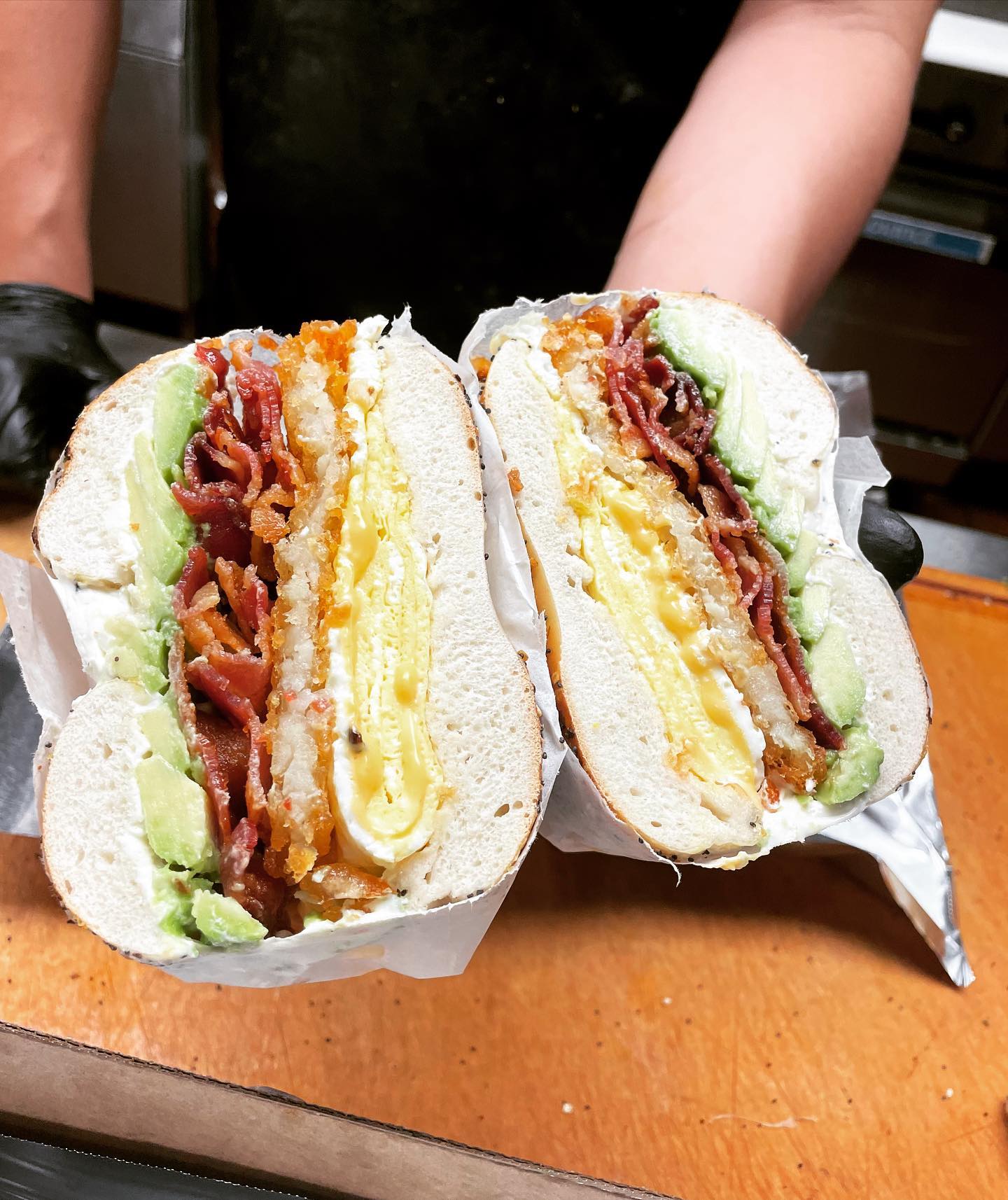
You’ll find some of the best bagels in Dallas at Shug’s. You can build your own egg sandwich layered onto a chewy bagel, or on a deli roll or wrap. Of course, the classic bagel and lox will warm your heart. It’s packed with plenty of smoked salmon, cream cheese and capers.
Shug’s Bagels sells deli meats, spreads and deli salads by the pound, perfect for filling your dorm fridge. It’s open daily from 7 am to 3 pm. It’s a favorite SMU stop for breakfast and lunch, but should you require bagels after hours, Shug’s makes that happen by also staying open 6 pm to 2 am Thursdays through Saturdays.
Must try: Order the BLT with three slices of bacon and add fresh avocado to your bagel sandwich.
Known for serving healthy bowls and hearty chopped salads, Original Chop Shop is the place SMU students drop in to get their greens. A selection of sandwiches are served on locally sourced breads. Or try a wrap customized just the way you like it.
Students seek out Original Chop Chop for its fresh smoothies and juice drinks too. That’s a meal you can sip in class. The Cool Down with watermelon and pineapple can help power you through fall and the Cold Buster with orange, carrot, ginger and turmeric might just keep you out of the Health Center.
Must try: Danish Salad tossed with house greens, arugula, smoked almonds, Danish bleu cheese and a mélange of fruits like pear, apple, black currant and dates in a red wine vinaigrette.
With everyone back on campus, eating well becomes a class of its own. Study up.
Spend a peaceful weekend in Mason City, home of Music Man Square and “Stockman House” designed by Frank Lloyd Wright.
1. The Historic Park Inn Hotel
No two rooms are alike in the last remaining hotel designed by renowned architect Frank Lloyd Wright.



Relax in this cozy cabin that blends modern updates with rustic charm.


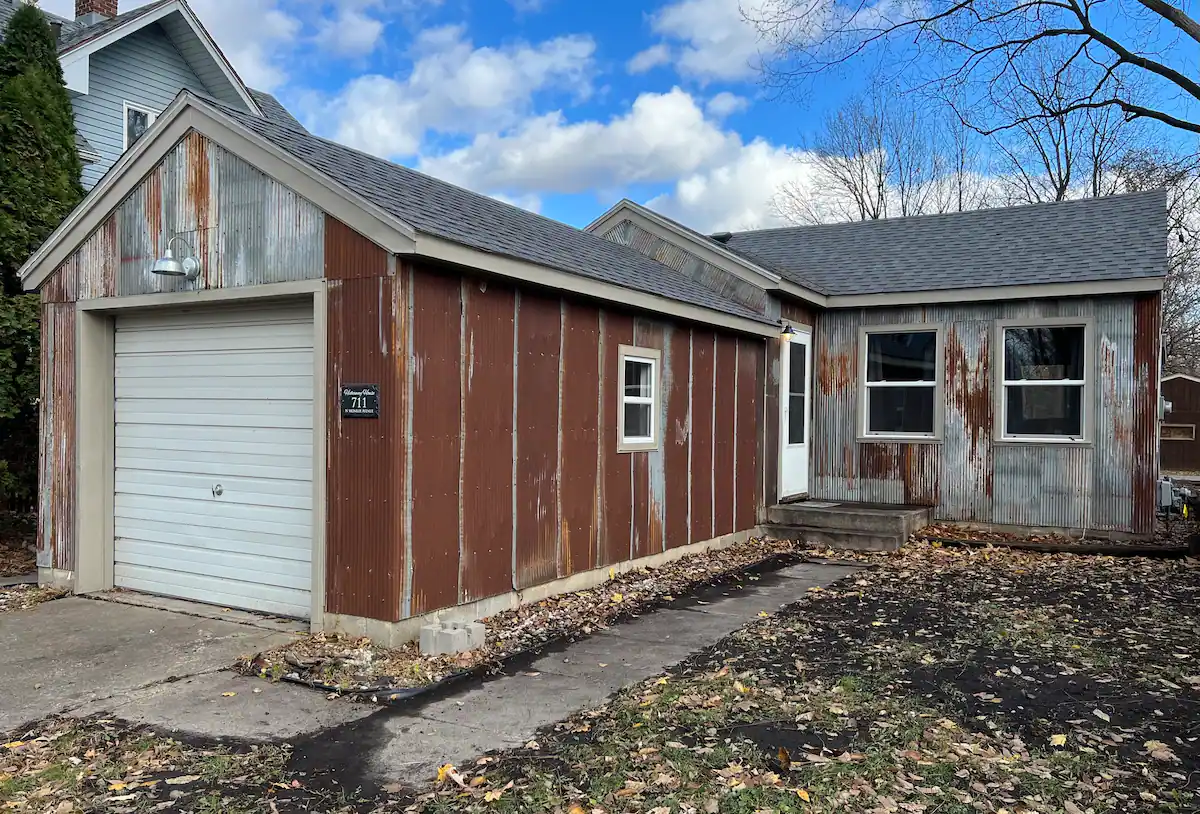
1. The Quarry
Treat yourself to fresh seafood and top-quality steak at this inviting spot that boasts a breezy patio.
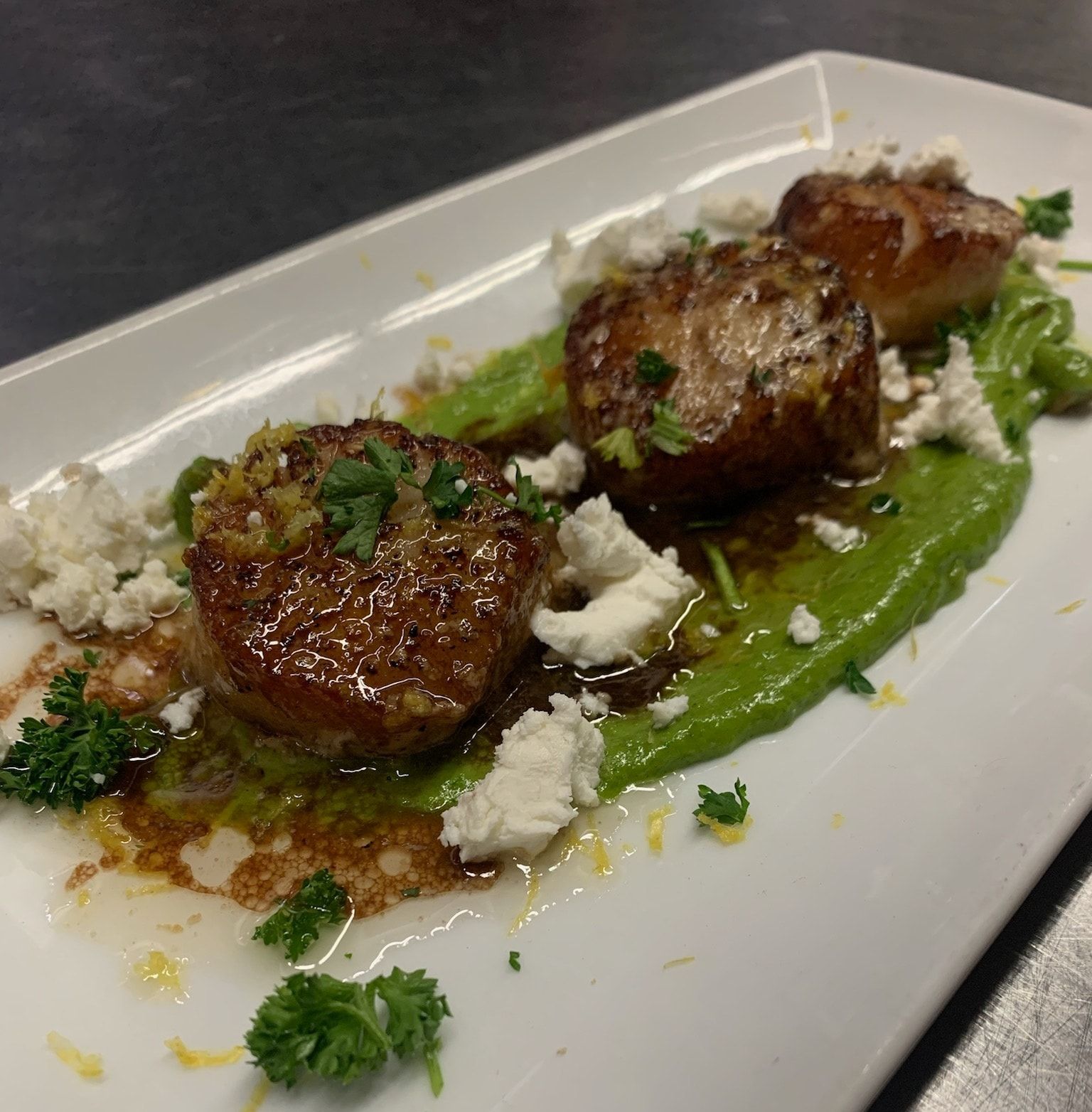
This basement bar is a gathering spot for locals and visitors alike, with billiards games, pop-up live music and $5 burger night on Wednesdays.

Grab a scoop at this iconic ice cream shop that's been in the same Mason City location since 1931.
1. Tour The Music Man Square
Experience the life and works of Meredith Willson, the Mason City native best remembered for his Broadway musical "The Music Man." Admission is $10 for adults or $5 for students.
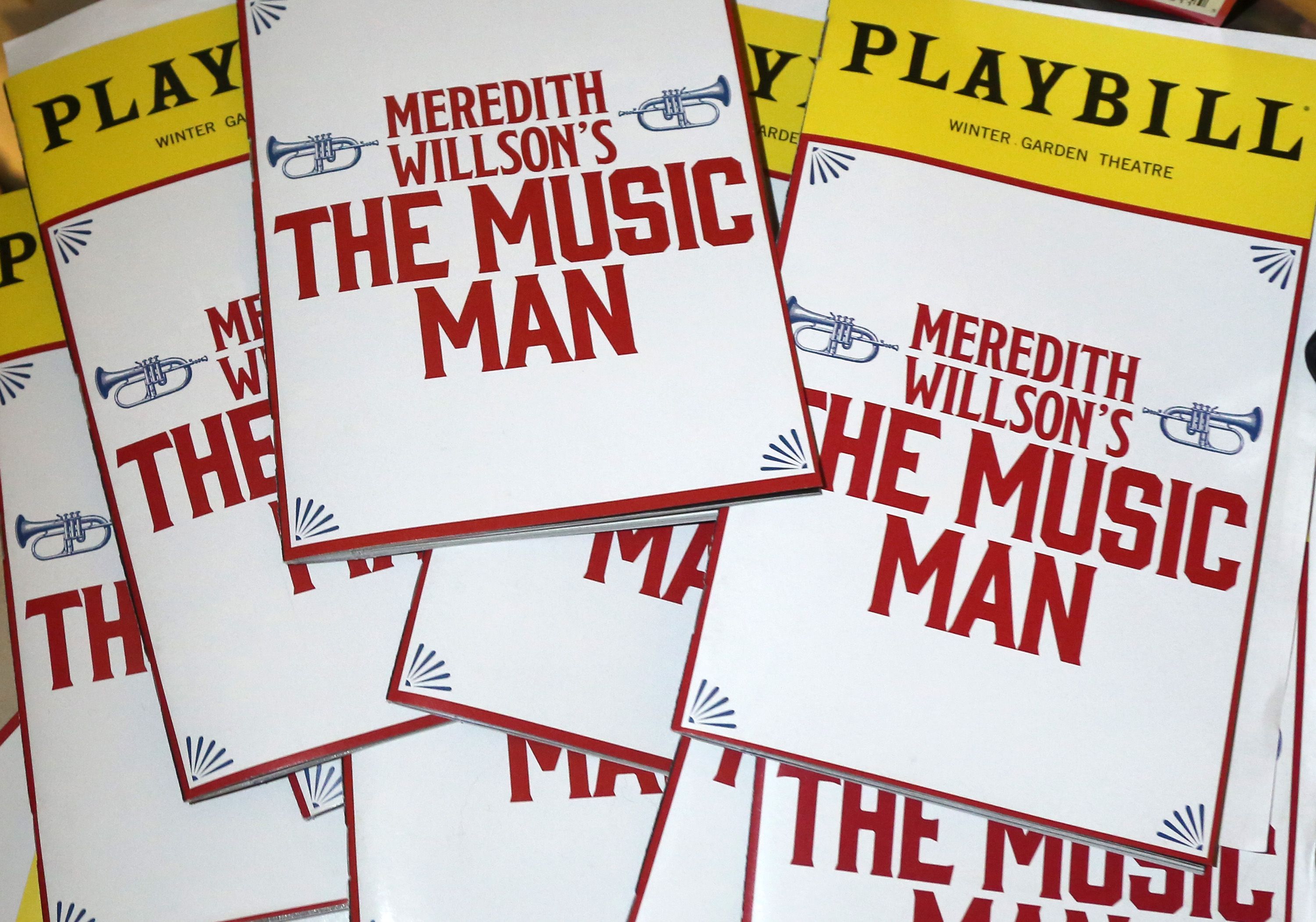
2. Explore the Stockman House
Get a first-hand view of Frank Lloyd Wright's architecture and his impact on Mason City. Tours cost $10 per person.
3. Catch a show at Mason City Brewing
Sip small batch beer while you partake in free trivia nights or enjoy live music and comedy events. Check the schedule.
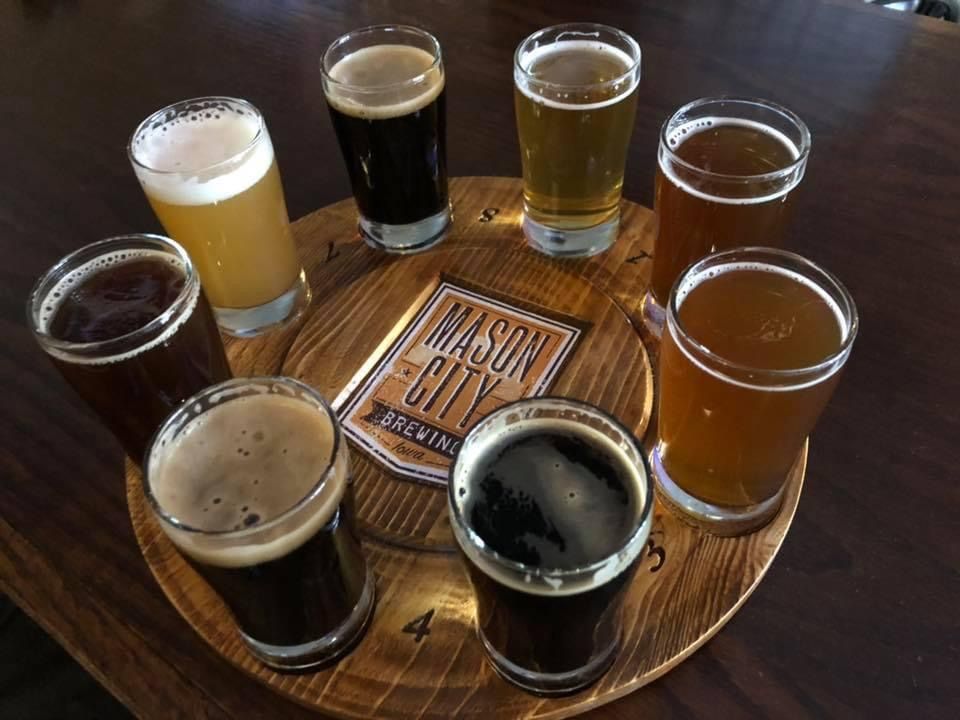
Brenham offers small-town Texas charm when you want to get away from the city. Located about one-and-a-half hours away, it's perfect for a weekend getaway or even a day trip.
This cozy barn is picturesque year-round and offers some rest and relaxation while still being near downtown.

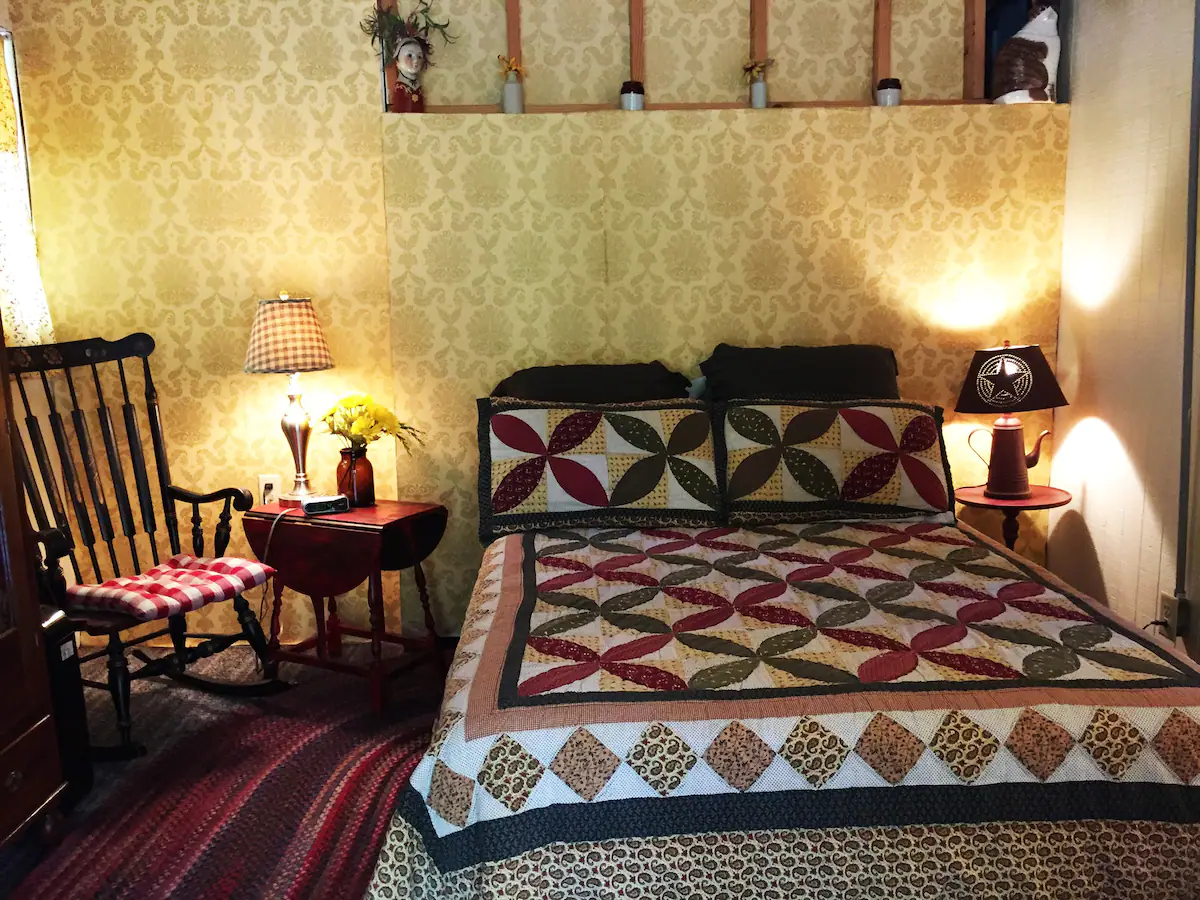
2. Antiquer's Cozy Self Contained Cottage
This peaceful cabin is three miles from downtown and a perfect home base for exploring nearby Lake Sommerville, Round Top and Warrenton.
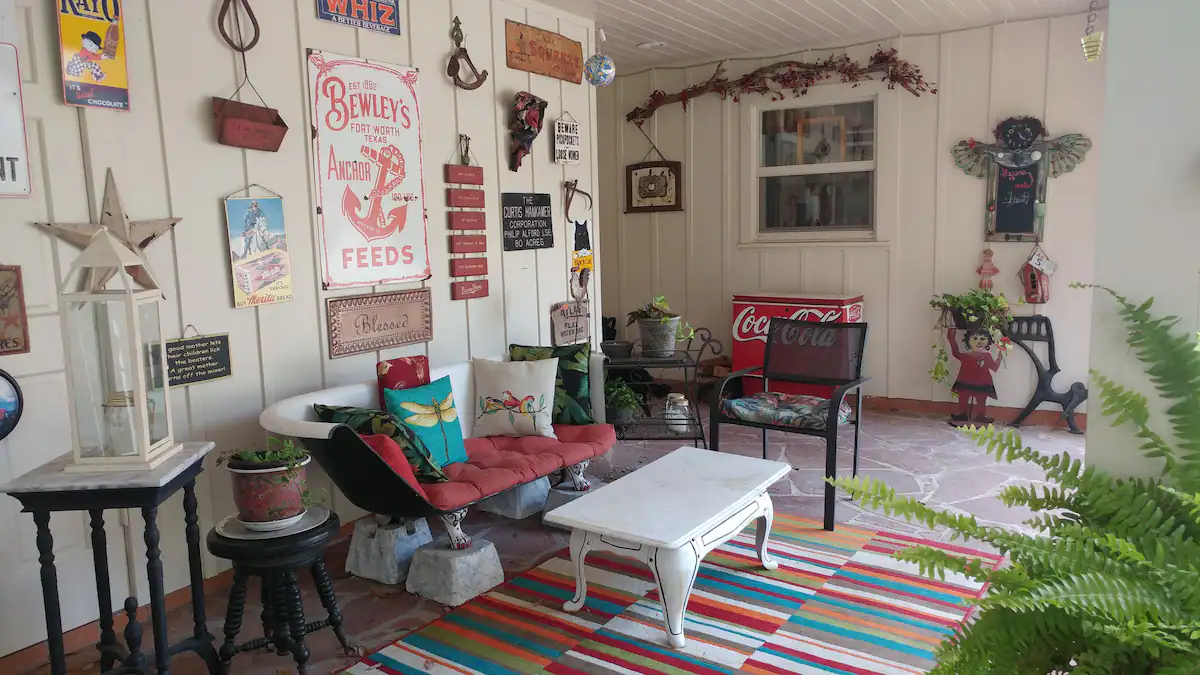

This centrally located abode has been renovated with modern amenities, elevating its traditional design.
1. LJ's BBQ
This true Texas barbecue spot serves smoked brisket, pork and other meats by the pound, plus an array of savory sides.

Sample this Italian bistro's fresh and house-made pasta dishes, like the pappardelle noodles served in a hearty wild boar sauce.
If you live in Texas, chances are, you've had the historic Blue Bell ice cream. Check out the museum and read up on its history. Plus: There are fun backdrops — perfect photo opportunity — and you can treat yourself to a scoop while you're there.
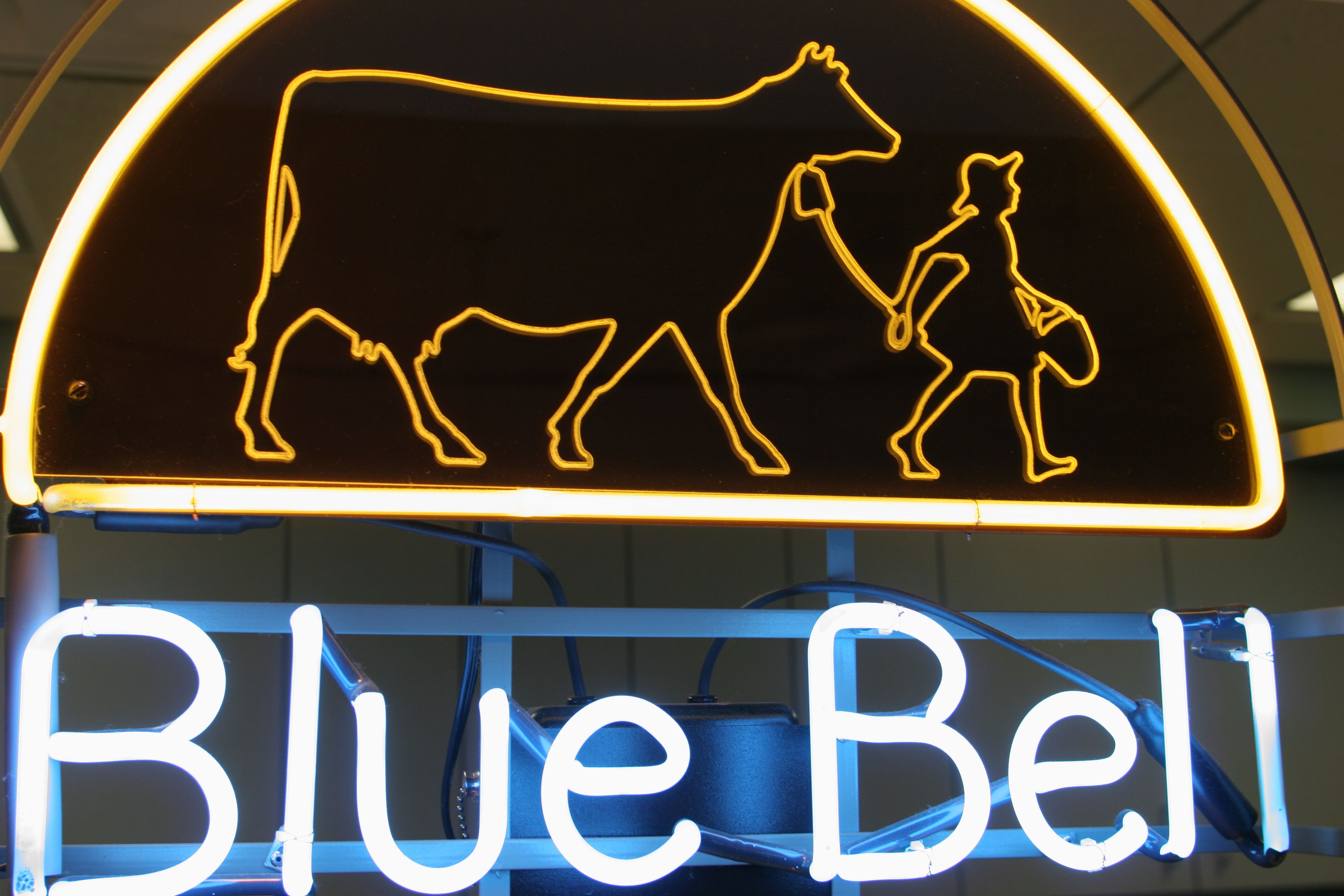
2. Bluebonnet sightings
Brenham is known for its bluebonnet fields from March through May. Plus, the nearby Chappell Hill holds a bluebonnet festival every year, and it's just a 15- minute drive away.

This rose garden is known for its abundance of rose varieties that are resilient and can survive Texas' harsh conditions. You can buy award-winning roses or simply wander the colorful gardens when the roses are in bloom.

The lives of our favourite celebrities are a source of much curiosity and intrigue among us. We often wonder how these stars stay in such ...
